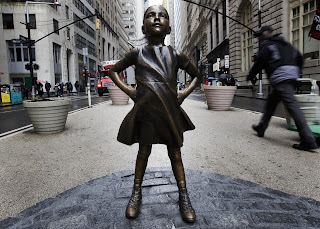Fraught and Fearless
I read a very interesting article yesterday, talking about the gorgeous statue of Fearless Girl, which has been placed opposite the Charging Bull on Wall Street, and it sparked a conversation about the meaning of art, and whether the intended message of an artwork can change when it is juxtaposed with another.
Fearless Girl was a commission by one of the investment firms based on Wall Street. The artist, Kristan Visbal, was paid by a corporation to create this faux-guerrilla statuette, initially only to be placed for a couple of weeks. The outpouring of love for what is, on its own, quite a kitsch little figure, has been such that Fearless Girl will stand for a little longer. But, she was designated to be a temporary tip of the bankers hat to an international awareness day, designed to temporarily guilt businesses into looking at the gender imbalance on their boards.
Image Source: The Boston Globe
I adore this statue: a small girl in the heart of a financial district, plucky and spirited, standing strong against a golden bull.
I adore what I was told she was representing: placed there for International Women's Day, she highlights the dearth of women in leadership roles.
Even as I have read more about the controversy around her, I still love the statue as a piece of art and the juxtaposition with the hyper-masculine bull charging towards her.
I adore what I was told she was representing: placed there for International Women's Day, she highlights the dearth of women in leadership roles.
Even as I have read more about the controversy around her, I still love the statue as a piece of art and the juxtaposition with the hyper-masculine bull charging towards her.
The artist of the bull is a gentleman called Arturo Di Modica. He installed Charging Bull one night in 1987, after spending two years and thousands of his own dollars creating it. He wasn't commissioned; he wasn't given permission. Charging Bull was a piece of guerrilla art, designed, says Di Modica, to represent the resilience of the American people during the financial crisis. The bull is the people charging the banks, and holding the bankers accountable to the people whose money they hold; hopefully reminding those who work on Wall Street that, every time they walk to work, they are answerable to the people.
Fearless Girl was a commission by one of the investment firms based on Wall Street. The artist, Kristan Visbal, was paid by a corporation to create this faux-guerrilla statuette, initially only to be placed for a couple of weeks. The outpouring of love for what is, on its own, quite a kitsch little figure, has been such that Fearless Girl will stand for a little longer. But, she was designated to be a temporary tip of the bankers hat to an international awareness day, designed to temporarily guilt businesses into looking at the gender imbalance on their boards.
Image Source: US Weekly
Di Modica is angry, and I understand why. The intention of his artwork has been undermined. Now his symbol of the anger and power of the American people is seen to represent everything it was created to resist: the banks, corporate power, and hyper-masculinity. Undermined by a statue commissioned by one of the companies it was raging against.
On the other hand, once a piece of artwork is in the public domain, does the artist have any right to dictate how it is perceived? We know that people like, or dislike, different things, and that's the beauty of art - how I read something may be completely different to how you read it, and that's fine, surely? Is art in the interpretation rather than the creation?






Comments
Post a Comment